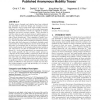Free Online Productivity Tools
i2Speak
i2Symbol
i2OCR
iTex2Img
iWeb2Print
iWeb2Shot
i2Type
iPdf2Split
iPdf2Merge
i2Bopomofo
i2Arabic
i2Style
i2Image
i2PDF
iLatex2Rtf
Sci2ools
MOBICOM
2010
ACM
2010
ACM
Privacy vulnerability of published anonymous mobility traces
Mobility traces of people and vehicles have been collected and published to assist the design and evaluation of mobile networks, such as large-scale urban sensing networks. Although the published traces are often made anonymous in that the true identities of nodes are replaced by random identifiers, the privacy concern remains. This is because in real life, nodes are open to observations in public spaces, or they may voluntarily or inadvertently disclose partial knowledge of their whereabouts. Thus, snapshots of nodes' location information can be learned by interested third parties, e.g., directly through chance/engineered meetings between the nodes and their observers, or indirectly through casual conversations or other information sources about people. In this paper, we investigate how an adversary, when equipped with a small amount of the snapshot information termed as side information, can infer an extended view of the whereabouts of a victim node appearing in an anonymous tr...
| Added | 06 Dec 2010 |
| Updated | 06 Dec 2010 |
| Type | Conference |
| Year | 2010 |
| Where | MOBICOM |
| Authors | Chris Y. T. Ma, David K. Y. Yau, Nung Kwan Yip, Nageswara S. V. Rao |
Comments (0)

